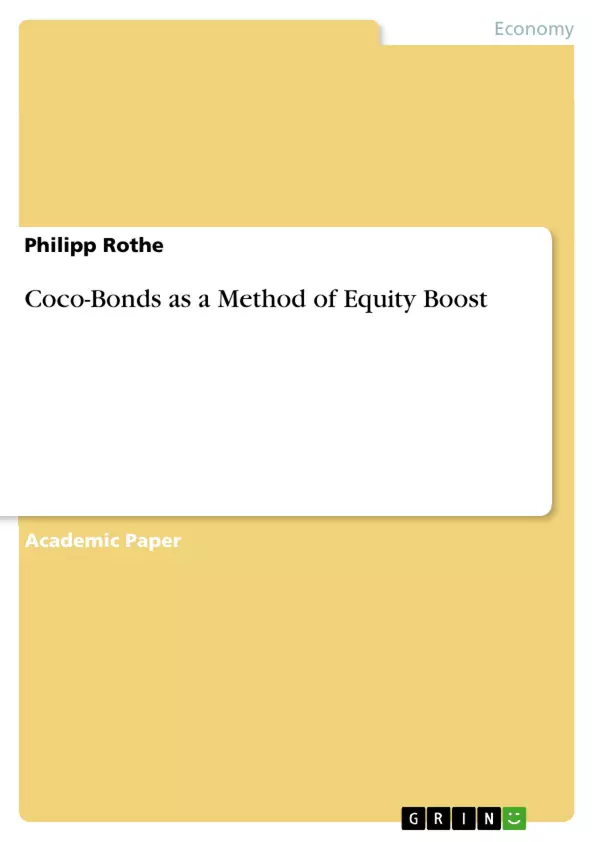This term paper will start with describing some basic characteristics of Coco-Bonds and their market behaviour. This first chapter should help to understand the product itself and its features. Afterwards the basic idea behind Basel III and resulting regulations under CRD and CRR are described and linked to Coco-Bonds as a product. In the last chapter it is discussed whether and under which circumstances Coco-Bonds belong to the equity capital of a bank and thus strengthen the equity base.
After the financial crisis in 2008 one of the main objectives the regulatory- and supervisory authority had, was to strengthen and increase the equity base of banks. This should ensure a better preparation for coming crises. In October 2011 the Basel Committee set the stage for a financial product, allowing it to play a ma-jor role in building up regulatory equity capital, as defined in Basel III. The product to reach the regulatory requirements are Contingent Convertible Bonds (short: Coco-Bonds). These bonds are a niche financial product which, as a result of the increasing regulatory requirements, in recent years were often issued by banks. Although these securities are issued as a bond with a fixed coupon, in case of a certain event, the Coco-Bonds are converted into equity or are written off. Due to this, Coco-Bonds often pay a high coupon rate, which could make them, especially within the currently low interest rate environment, look like an attractive investment. However a high coupon payment always means a related risk.
Inhaltsverzeichnis (Table of Contents)
- Introduction
- Characteristics of Coco-Bonds and their market behaviour
- Coco-Bonds and their ability to meet regulatory requirements
- Conditions under which Coco-Bonds can serve as equity capital
- Executive summary
- Literature
Zielsetzung und Themenschwerpunkte (Objectives and Key Themes)
This term paper aims to explore the characteristics and market behavior of Contingent Convertible Bonds (Coco-Bonds) in light of the regulatory landscape following the 2008 financial crisis. The focus is on understanding the role of Coco-Bonds in fulfilling regulatory requirements, particularly within the Basel III framework, and examining whether these bonds can contribute to strengthening the equity base of banks.
- Characteristics and Market Behaviour of Coco-Bonds
- Regulatory Requirements and Basel III Framework
- Coco-Bonds and Equity Capital
- Coco-Bonds as a Potential Solution for Strengthening Bank Equity
- The Role of Regulators in Managing Coco-Bonds
Zusammenfassung der Kapitel (Chapter Summaries)
- Introduction: This chapter provides an overview of the financial crisis of 2008 and the subsequent regulatory focus on strengthening the equity base of banks. It introduces Coco-Bonds as a financial product designed to meet these regulatory requirements and highlights their unique features, including conversion into equity or write-off upon specific events.
- Characteristics of Coco-Bonds and their market behaviour: This chapter delves into the characteristics of Coco-Bonds, including their convertibility feature, trigger events, and high coupon rates. It discusses the market behavior of these bonds, highlighting investor demand and the role of hedge funds and asset managers in their purchase. The chapter also explores the unlimited duration and potential repayment mechanisms associated with Coco-Bonds.
Schlüsselwörter (Keywords)
The main keywords and focus topics of this term paper are: Contingent Convertible Bonds (Coco-Bonds), Basel III, regulatory capital requirements, equity capital, financial crisis, trigger events, conversion, write-off, market behavior, investor demand, high coupon rates, unlimited duration, regulatory oversight, financial institutions, banking industry.
- Quote paper
- Philipp Rothe (Author), 2021, Coco-Bonds as a Method of Equity Boost, Munich, GRIN Verlag, https://www.grin.com/document/1357311



